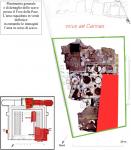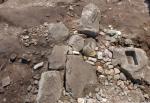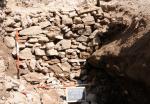Summary (English)
Excavations have been taking place inside the Forum of Peace since 2012, carried out by the Special Superintendency for the Colosseum, MNR and the Archaeological Area of Rome and by the Roma Tre University, Since 2014, the American University in Rome has also been taking part. The aim is to improve the visibility and comprehension of this part of the Forum of Peace, and to this end the Severan floor of large marble rotae is being gradually exposed and work carried out that will provide a better understanding of its architectural form (Fig. 1).
The occupation phases dating from the end of antiquity to the present day have been investigated during the course of three campaigns. The monument fell into ruin during the 6th century A.D., as attested by layers of burning immediately above the floor surface. The first robbing, the selective removal of the large porphyry rotae, probably occurred soon afterwards (Fig. 2). Following this first episode of robbing, the area was used for a long period, at least until the 11th century, for dumping detritus and organic material. At first these accumulations were contained within a series of small dry-stone walls, built with materials recovered from the area (Fig. 3). Later, attention was no longer paid to the spatial organisation and the layers rapidly accumulated, interrupted by the occasional occupation level attested by hearths and precarious structures of reused peperino blocks and bricks. These levels were only visible in sections that were too small to enable the reconstruction of any plans (Fig. 4).
A second phase of robbing occurred between the 12th and 13th centuries. This was well-organised and the materials to be recovered were carefully selected. The first elements to be dismantled were the giallo antico column drums from the pronaos. Trenches were then dug to search for the travertine foundation blocks of the monument’s colonnades and perimeter walls. The work proceeded in sectors with the removal of the blocks, the back filling of the excavated section and the construction of dry-stone structures to stabilize it (Fig. 5). Systems of ramps provided access to the trenches and were used to get the recovered blocks out. This intense activity led to the total disappearance of the standing structures and the monument’s existence was forgotten. The next phase, linked to the new construction project promoted by cardinal Bonelli and the Della Valle family between the late 16th century and the early 17th century, saw the urbanisation of the area. The new quarter, known as the Alessandrino district, remained largely unchanged until the 1930s, when it was demolished to make room for the via dei Fori Imperiali.
In 2015, excavations reopened on the road skirting the rear of the Forum of Peace, known in antiquity as the vicus ad Carinas, because it linked the Roman forum to the area of the Carine. Its route has remained unaltered to the present day and is still recognisable in the via del Tempio della Pace. Further investigations were undertaken on a cobbled surface dating to the 13th century that was uncovered during previous excavations. This surface was limited in size and probably a sporadic intervention that was not part of any planned maintenance.
The particular interest of this area of investigation derives from the fact that it is one of the very rare cases in the city of Rome, where it is possible to analyse the stratigraphy of an ancient road that continued in use until the modern period
- Giulia Facchin
- Riccardo Santangeli Valenzani - Università degli Studi Roma Tre
Director
- Riccardo Santangeli Valenzani - Sovraintendenza ai Beni Culturali Comune di Roma
- Rossella Rea - Soprintendenza Speciale per i Beni Archeologici di Roma
Team
- Luca Brancazi – Università di Roma Tre
- Giuliano Giovannetti – Università di Roma Tre
- Noemi Evangelista – Università di Roma Tre
- Viola Giardini – Università di Roma Tre
- Francesca Montella - Soprintendenza Speciale per il Colosseo, il MNR e l’Area Archeologica di Roma
- Lucrezia Campagna – Università di Roma Tre
- Martina Bernardi – Università di Roma Tre
- Michela Stefani – Università di Roma Tre
Research Body
- Soprintendenza Speciale per il Colosseo, il MNR e l’Area Archeologica di Roma
- Università degli Studi Roma Tre
Funding Body
- Ministero dei Beni e delle Attività Culturali e del Turismo






![Download [PDF]](/excavation/skins/fasti/images/results/download_sml.png)


